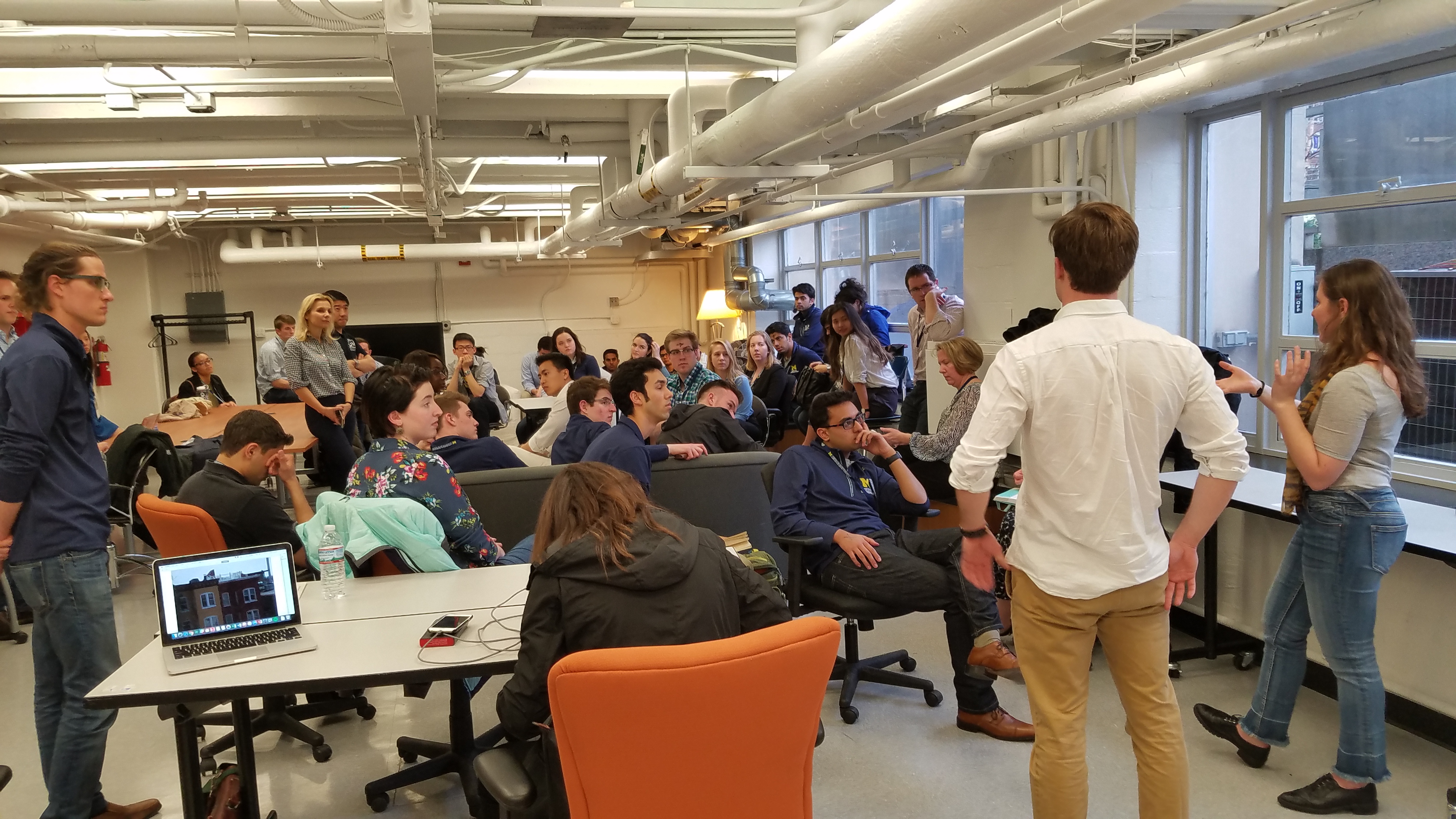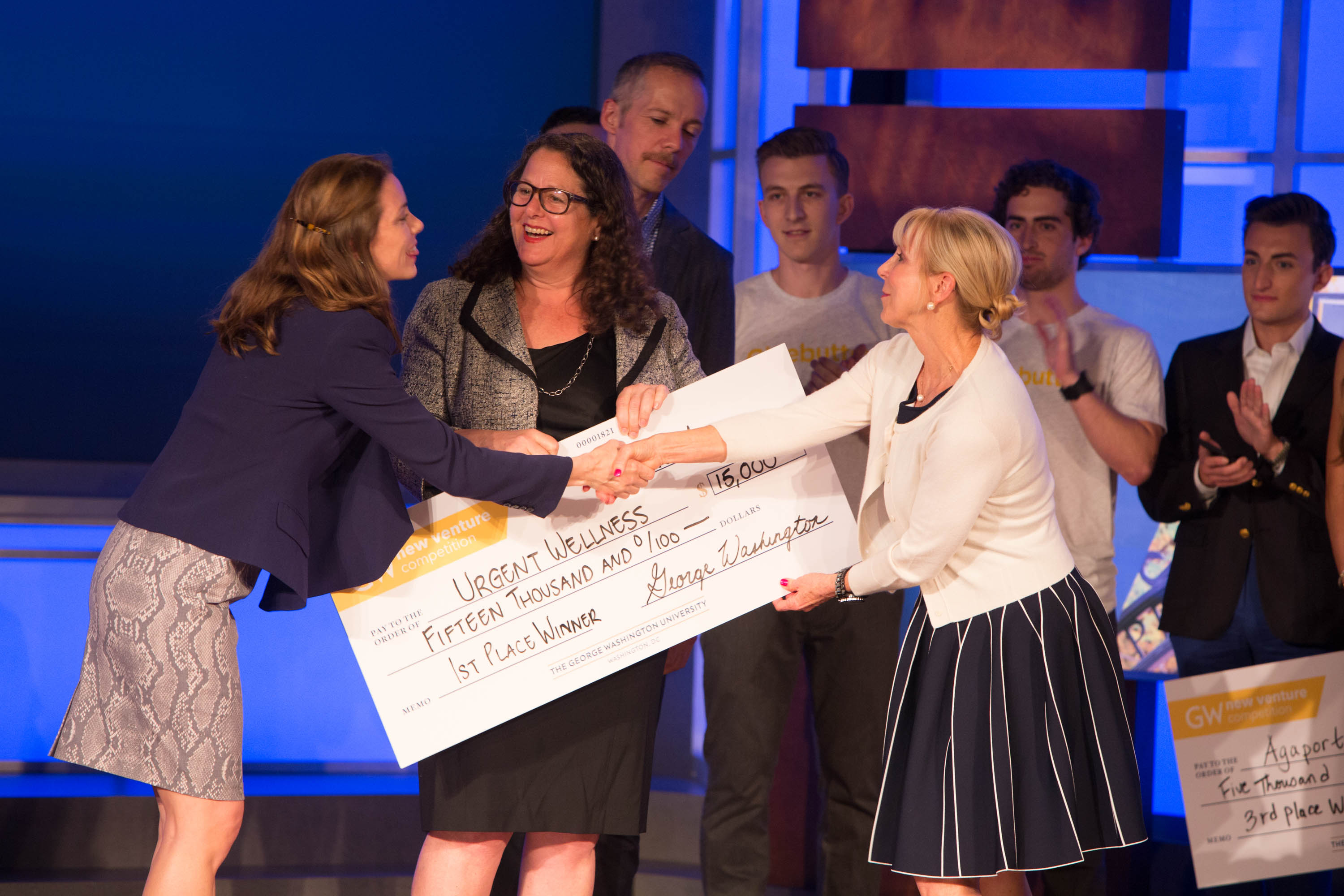Innovators across George Washington University have a new place on campus where they can kick around ideas for a business venture, receive help from mentors, listen to speakers and participate in workshops—and maybe even meet investors or launch their ventures.
The new innovation center, located on the mezzanine level of Tompkins Hall, is a joint initiative led by Dean David Dolling and the School of Engineering and Applied Science and the Office of Innovation and Entrepreneurship, which is part of the Office of the Vice President for Research.
Annamaria Konya Tannon, SEAS chief evangelist of innovation, entrepreneurship and invention, said the center is a critical piece of Dr. Dolling’s mission to build a culture of innovation at SEAS and to partner with the Office of Innovation and Entrepreneurship and others across the university who are doing the same.
“To build an innovative culture, we must have a physical space where like-minded people from across the university can creatively and collaboratively address the same social or commercial issue,” said Ms. Konya Tannon.
The 988-square-foot room in Tompkins Hall, which used to be home to the engineering school’s machine shop—is undergoing a makeover so it can become that space for the university.
SEAS financed much of the renovation of the space, along with the Office of Innovation and Entrepreneurship, which also has provided programming and on-site staffing.
The floors have been replaced and the walls painted white to create a blank canvas. Temporary furniture in various configurations creates multiple meeting spaces, while the center awaits a design and furniture upgrade based on ideas submitted by three teams of graduate students from the Corcoran School of the Arts and Design.
The students developed design proposals for the space, including names, color schemes, logos, branding and furniture designs that fit the center’s collaborative purpose. SEAS solicited the proposal for designs from the Corcoran School, and work is already underway to submit another proposal to have the students work on executing the selected design. Donations are being sought to help fund renovations and expansion of the center.
Each stage of the process to outfit and expand the innovation center is undertaken with an eye to the goal of the center.
“We’re trying to provide a continuum of support with the innovation center, so we can take innovation from ideas to nascent companies,” said Lex McCusker, director of student entrepreneurship programs for the Office of Entrepreneurship and Innovation. “We need this space to be able to do that, and then we can bring investors in.”
The space is already being used by students, faculty and mentors. Mentors-in-Residence hold daily office hours, and all GW students have access to the center from 7 a.m. to 10 p.m.
Jim Chung, associate vice president for research, innovation and entrepreneurship, said it’s exciting to see new cross-school student collaborations developing between like-minded students now that they have a dedicated space to connect
“Because the world is becoming increasingly complex, innovation is coming more and more from the collisions between different disciplines,” he said. “The innovation space provides the intersection for great ideas to form from those collisions.”
This summer the innovation center will offer several initiatives to nurture interdisciplinary idea creation and new ventures. Some, such as the SEAS class “New Venture Creation Using Design Thinking,” will focus on local problems. Through the class, teams of GW students will develop innovative ways to address public health issues identified by D.C. government officials, such as improving trash collection and reducing rodent populations.
Another initiative looks to promote female entrepreneurship in North Africa and the Middle East, as the innovation center hosts 10 female entrepreneurs from North African countries this summer in conjunction with the World Bank’s WeMENA program.
As programming in the center grows, Ms. Konya Tannon foresees the center giving GW students more opportunities to develop their ideas, potentially even into viable companies.
“Education and academia is changing, and we are accommodating this change and bringing it to the GW campus. We want to impart those soft skills that might land you your dream job,” she said. “This is a space where you can investigate, explore and practice solving social or commercial problems while you are still in school.”
In the fall, the National Science Foundation provided $3.45 million in renewal funding for the DC I-Corps Node to support entrepreneurship. GW works alongside three additional collaborating institutions to train entrepreneurial student and faculty researchers and help them bring their discoveries to market.
It was announced in March that GW will also receive nearly $500,000 over the next five years from the National Science Foundation to create an I-Corps Site at the university with the goal of recruiting student and faculty teams to develop technologies for commercialization. The GW site will award micro-grants to at least 50 teams each year, money they will use to interview prospective customers and build prototypes.
Mr. McCusker said he hopes having a targeted space for entrepreneurial collaboration inspires the GW community to think more about their own ideas for products or start-ups.
“We want to welcome everybody in the GW community, faculty, staff, students, alumni to come down and visit,” he said. “Drop in, have a cup of coffee, sit with students and kick around ideas. Network and meet other people, that’s what this space is for.”




